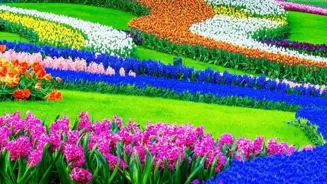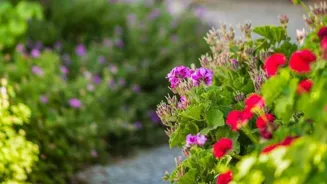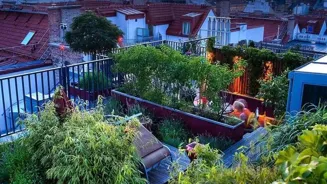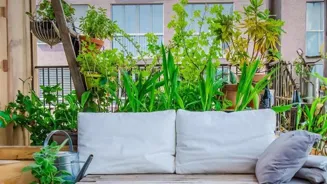Discover how to infuse your space with Mughal garden magic! Craft your own sanctuary with these 5 stunning inspirations
The Mughal garden, with its geometric precision, flowing water features, and vibrant
blooms, has always held a special place in our hearts. Remember visiting Shalimar Bagh in Srinagar, the scent of roses hanging heavy in the air, or the serene beauty of Pinjore Gardens near Chandigarh?
That regal charm isn't just for palaces and historical sites anymore. You can bring a slice of that Mughal magic right into your home!
We're not talking about recreating a sprawling palace garden, but rather incorporating elements – the symmetry, the water, the fragrant plantings – to create a tranquil haven, be it a balcony, a terrace, or a cozy corner indoors.
So, ditch the mundane and get ready to infuse your living space with some seriously majestic vibes!
Mughal gardens: principles, symmetry, water, fragrance, small spaces tips
First things first, understand the core principles. Mughal gardens aren’t just about pretty flowers; they’re meticulously planned spaces reflecting paradise on earth. Symmetry is key. Think of dividing your space into quadrants, mirroring elements on each side.
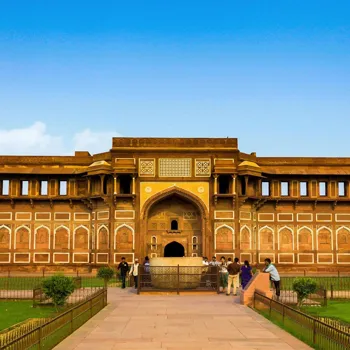
Water plays a crucial role – a small fountain, a shallow reflecting pool, or even a strategically placed birdbath can mimic the calming effect of a flowing canal. Fragrance is another deal breaker. Jasmine, roses, and champa – these aromatic beauties are Mughal garden staples.
Don't be intimidated if you have limited space. You can achieve a similar effect by using planters of varying heights to create layers, incorporating mirrors to give the illusion of depth, and focusing on vertical gardening with climbing plants like bougainvillea or jasmine.
Remember, the goal is to evoke a sense of tranquility and order, a space where you can escape the chaos of daily life. Begin by identifying your space and it's lighting.
Mughal garden concept: adapt "Charbagh" layout with distinct zones in home
Next, let’s dive into some specific inspirations. The Charbagh layout, meaning "four gardens," is a fundamental Mughal garden concept. Imagine a square garden divided into four sections by pathways or waterways.
You can adapt this to your home by creating four distinct zones in your balcony or terrace. One zone could be a seating area, another a mini herb garden, the third a display of colourful flowering plants, and the fourth a small water feature.
The pathways could be simple paved areas or even just lines of pebbles or decorative stones. Another key element is the use of geometric patterns. Incorporate these into your tile work, paving designs, or even in the arrangement of your plants.
Think of intricate jaali patterns replicated in metal screens or painted on planters. These details add a touch of elegance and visual interest.
Choosing fragrant, visually striking plants essential for garden design
Moving beyond the layout, let's talk about plants. While you might not be able to grow everything seen in Mughal gardens, choosing fragrant and visually striking plants is crucial. Roses are a must-have. Opt for varieties that thrive in your local climate.
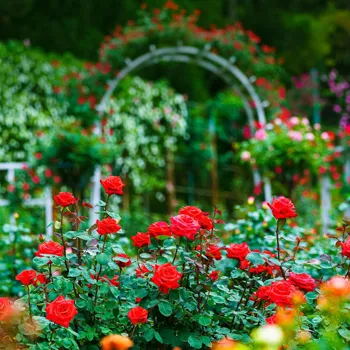
Jasmine, with its intoxicating scent, is perfect for trailing over walls or trellises. Marigolds, with their bright colours, add a cheerful touch. Consider adding herbs like mint and basil, not only for their aroma but also for their culinary benefits.
Remember to group plants with similar needs together. For instance, place sun-loving plants in the sunniest spot and shade-tolerant plants in a more sheltered area. Don't forget about the importance of foliage. Ferns, with their lush green fronds, can add a touch of coolness and serenity.
Water features enhance gardens, attracting wildlife and creating a serene ambiance
Water features are the soul of a Mughal garden. If you have the space, a small fountain or a shallow reflecting pool can create a truly magical atmosphere. Even a small birdbath can attract birds and add a touch of life to your space.
If space is limited, consider a wall-mounted fountain or a tiered water feature. The sound of trickling water can be incredibly soothing and can help to drown out city noise. Remember to keep your water feature clean and well-maintained to prevent algae growth.
Add aquatic plants like water lilies or lotus to further enhance the beauty of your water feature. Consider adding colourful stones.
Transform your Mughal-inspired garden with strategic lighting choices
Lighting can dramatically transform your Mughal-inspired space, especially in the evenings. Soft, warm lighting can create a romantic and inviting atmosphere. Use a combination of ambient lighting, task lighting, and accent lighting to highlight different features of your garden.
String lights are a great way to add a festive touch. Consider using lanterns or spotlights to illuminate your plants and water features. Uplighting trees or walls can create dramatic shadows and add depth to your space.
Remember to choose weather-resistant lighting fixtures that can withstand the elements. Solar-powered lights are a great option for energy efficiency.
Create a personal Mughal garden reflecting your style and heritage
Finally, don't be afraid to add your personal touch. While staying true to the core principles of Mughal garden design, feel free to incorporate elements that reflect your own style and personality. Consider adding colourful cushions, throws, and rugs to your seating area.

Display your favourite sculptures or artwork. Incorporate elements of your culture or heritage. Mughal gardens were always intended to be places of personal enjoyment and reflection, so make sure your space reflects that.
Remember, the goal is to create a sanctuary where you can relax, recharge, and reconnect with nature. So, go ahead, unleash your inner Mughal and transform your home into a little slice of paradise!
AI Generated Content. Glance/InMobi shall have no liability for the content

